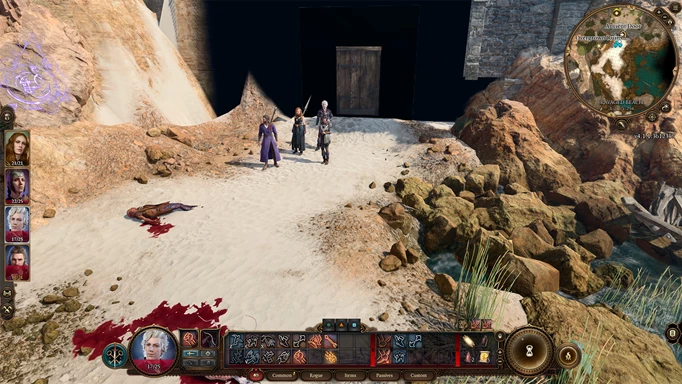Baldur's Gate 3 review: Unmissable adventure is the gold standard of RPGs

It’s the noughties, and I’ve just finished a playthrough of one of my favourite games growing up: Baldur’s Gate: Dark Alliance. Those initial stages spent exploring the cellars and thwarting rats are burned into my mind. It was, undoubtedly, one of the titles that set me on the path to the RPG genre being my go-to.
All these (many, many) years later, little me could have only dreamed of sitting down with another entry in the series: Baldur's Gate 3 - and I’m pleased to say that both myself and my inner child had our cake and got to eat it too.
As someone who also played Larian’s Divinity: Original Sin 2 entry effectively cover to cover multiple times, I was expecting big things - and Baldur's Gate 3 delivers on those expectations by the boatload.
GGRecon Verdict
Baldur's Gate 3 is a gold standard for RPGs, setting the bar incredibly high for future games in the genre - and it's something I know I'll be coming back to time and time again in the future.
With a cast of fleshed-out, fully realised characters; tactical turn-based combat that presents an opportunity to stop, think and plan your attack strategically; and a dizzying amount of customisable choices, BG3 is truly a roleplayer's dream.
An opening of epic proportions

 Click to enlarge
Click to enlargeRight from the outset, Larian promises you a show. Whether it’s the tongue-in-cheek explicit content filter screen that pops up even before the main menu with a dimly lit, intricately decorated room or the sweeping orchestral score that has the lyrics “down, down, down by the river” playing in my mind on a loop, there’s a lot here that makes Baldur’s Gate 3 memorable right out of the, uh, gate.
As you venture into the character creator, the theme carries over from the main menu, screaming - not literally - ‘epic adventure ahead!’ as you choose your race, class, background and appearance.
With three difficulty settings that can also be changed on the fly during gameplay, ranging from Explorer (a more narrative-friendly experience) to Balanced and Tactician (slated as a “tough campaign emphasising strategic combat”), you’re able to choose a pace that fits your personal preference.
As someone much more invested in narrative and worldbuilding than combat, the Explorer mode felt like the best choice for me - but given how difficult some of the battles can still be in this mode, Tactician players can undoubtedly expect a challenge.
Frankly, the options presented in the character creator are overwhelming in the best possible way as you decide to play either an Origin story with one of seven premade characters - that also serve as companions in-game - or craft your own character from 11 different races ranging from Human to the scaly Dragonborn.
If Origin Characters tickle your fancy, there’s a diverse cast here to choose from, ranging from the highly-strung Astarion - an elf with an air of grandeur that has long served a vampiric master and is now free to seek his revenge - through to the amnesiac Dark Urge.

 Click to enlarge
Click to enlargeEach one has its own introduction that can be listened to, effectively serving as a monologue that sets the stage for their backstory and motivations.
Take The Dark Urge, for example, a unique Origin not only because they can be fully customised to your liking, but because their narrative hinges on an uncontrollable - as the name suggests - urge that causes them to want to mindlessly seek blood and death. Their plight is that they want to resist it, discover who they were prior to this, and prevent a “tragedy in blood”.
Though you aren’t able to fine-tune your character’s face through the likes of sliders, there’s still a wide array of options on offer here that had me spending a good hour or so crafting my many characters (I counted over eighty hairstyles, for example).
Additionally, there’s a total of eight voices to select from, different body types for certain races, and you can choose freely between the male, female, and non-binary identities as you see fit alongside additional options for your character’s genitalia.
Some races, like the Drow, present additional subraces that have slightly different lore and add an additional layer to your character too. What’s more, classes like the Sorcerer or Warlock have their own subclasses, giving you a slightly different style of play within them depending on your preferences for a further layer of customisation.

 Click to enlarge
Click to enlargeBackgrounds are my favourite thing on offer here, though, as they add depth to your customised character that carries through with them alongside your class choice, making each decision you make here feel impactful even before you’re into the game itself.
- Check out our review of Ratchet & Clank: Rift Apart's PC port
Friends like these

 Click to enlarge
Click to enlargeThe story thread that leads you throughout the realm of Faerûn has you racing to remove and understand a parasite that was placed within your head - something that threatens to kill you if you aren’t quick, turning you into a tentacled Mind Flayer - and nobody wants that.
Of course, though, it's never quite that straightforward as you hop from quest to quest, stumbling upon a multitude of curiosities that have you uncovering more of the world you're inhabiting.
The opening cutscene presents a huge ship known as a Nautiloud that speeds across the skies of a city, abducting civilians into horrific pods and crushing buildings with a tail (yes, really).
It’s on this ship that your saga begins as you try to escape and understand just what happened to you. Along the way you’ll come across Origin Characters that can be recruited as companions (a total of four, including yourself), the first of which is Lae’zel, a Githyanki.
Initially, she may come off as abrasive and rude - but her story and the knowledge her character holds only add to the complexities she has, finding herself a fish out of water in a place completely unfamiliar. It’s these backstories, woven in with conversation options, that make each companion feel much more fleshed out than the majority of protagonists in other games.

 Click to enlarge
Click to enlargeAs you locate more companions in Baldur's Gate 3 and adventure with your band of merry heroes, you’ll learn about their personal stories and uncover details that give you more insight into them: Will you help Gale with an orb in his chest that requires him to consume magical items; or agree to a request from Astarion to sate his hunger, or help him uncover just what that tattoo on his back means?
The choice is yours to make, as Larian gives you plenty of dialogue options to choose from that help you shape your player fantasy.
Some choices will present a dice roll, adding a sense of RNG to the game for another layer of replayability and tabletop tactility, though I must admit I have been known to reload a save for a choice that I have really wanted to succeed if the Karmic Dice should fail me.
It’s also with Lae’zel and your fellow crash survivors that you discover you and your companions share a sort of telepathic connection bestowed on you by these tadpole-like creatures residing within your head (we’ve all been there, haven’t we?).
While exploring the world, your companions will either approve or disapprove of certain actions you take, which can affect your relationship with them as you play - adding another layer of complexity to the choices you make if you’re trying to keep in someone's good books.
Interactions with others throughout the world will spur on the occasional bit of dialogue from your party too. One of the biggest 'should I, shouldn't I' choices you'll be presented with early on is if you want to consume additional tadpoles as suggested by your Guardian - the other character you create when starting a new save - and your party will react to that and input whether they want to consume more too.
In this case, Astarion (my favourite companion and the character my Drow has sparked up a bit of a romance with, in case you were wondering) was completely on board right from the outset, asking if he could also have one as soon as I found one on the body of a priestess.
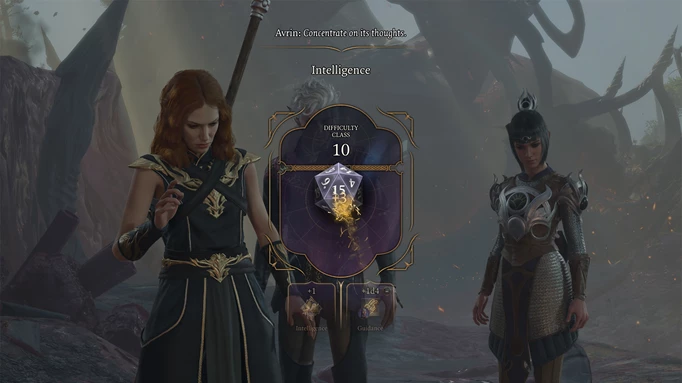
 Click to enlarge
Click to enlargeYour team will also occasionally chat with one another, helping them to feel like fully realised rounded individuals with thoughts, and by extension make Baldur’s Gate 3’s world feel like one that continues existing, even in your absence. In one instance while exploring, Shadowheart asked Gale about a previous comment he made earlier on - giving the sense that it's been on her mind ever since he made it.
Some even have intertwining narratives, as upon speaking with Wyll for the first time, he mentions Karlach - another of the Origin Characters - and his desire to hunt her down. Though this confrontation was tied up pretty neatly following an interaction between the two with Wyll in my party, I loved how this made me wonder about how that would go if you're playing as Karlach or as Wyll - there are so many variables here that will absolutely cause you to want to start multiple playthroughs just because of a small little choice.
All of these elements culminate to make Baldur’s Gate 3’s cast feel like some of Larian’s most genuine characters yet. My chosen party members of Astarion, Gale, Lae'zel, and Shadowheart (I'll switch between them from time to time, as you're allowed a maximum of three companions at once) have become characters that I feel like I've grown a genuine rapport with - and I care about how they view the decisions I make, as you never know when a 'Gale approves' will pop up in the top-left of your screen.

 Click to enlarge
Click to enlarge- Consider yourself a Simmer? Here's why we think the Horse Ranch DLC is more Game Pack than an Expansion
Spoilt for choice
Whether you decide to play from the isometric perspective or pick up a controller and zoom right in to a third-person to explore Faerûn, Baldur’s Gate 3 always offers something to look at, interact with, and multiple ways to tackle a situation.
As an early access player, I have retreated elements of Act 1 that I’ve already reached in previous characters plenty of times (I'm a sucker for multiple playthroughs to try different outcomes), but each time has felt unique in its own way, and some ruins found quite early on highlights the different ways to access different areas in the game.
With my Sorcerer, whose primary ability is in Charisma, I was able to completely avoid a fight with a group of characters outside it by persuading their leader, whereas in the past I’ve had to instead battle them. Following that, you can pretend to be the boss of the character behind the locked door or shoot a stone block so that it drops into the broken ground below to get inside.
On my Drow Warlock, however, thanks to Astarion's deft hand with a lockpick, I completely avoided needing to access the top-level of the ruins by venturing around and lockpicking my way into a trapdoor, where I found myself in a Dank Crypt that connects to the ruins when exploring it from the inside.
In the world itself, there’s so much worldbuilding here that you can wile away the time exploring, reading excerpts from books, looking at different plaques or simply by chatting to those that inhabit it. A Druid Grove and the town of Reithwin had me meandering around for what seemed like hours, wanting to chat and take up side quests as if I didn’t have a parasite chilling out in my head.

 Click to enlarge
Click to enlargeThe sheer amount of variables you'll find that become clearer with other characters makes Baldur's Gate 3 a jaw-dropping feat, too. That's not all though, because some of the choices are genuinely gut-wrenching to make. Take one of the biggest choices you'll likely find yourself deciding upon in Act 1, for example: whether to aid a Druid grove or have a part in condemning all that reside there.
As I tend to very much be ruled by my own moral compass when making decisions in games and chose to align with the Druids on my Sorcerer save, for my Drow Warlock I decided to go against that and slaughter the grove to align with another Drow character, Minthara.
The fallout that followed throughout that event and during the battle itself had me sick to my stomach, and after coming away from the game for an evening, I found myself needing to reload to a save two hours prior to undo those choices I made. I'd never try something like this usually, and it's a testament to Larian's fantastic writing and storytelling that I'd choose to abandon that to attempt to explore something quite frankly, evil.
What's great is that you can also completely avoid all of this fighting and skip straight past it by taking another, lesser-known route that's incredibly sneaky - though I won't spoil just what that is here. This is a thread that presents itself often throughout Baldur's Gate 3 - you can avoid certain encounters entirely just by being silver-tongued (and of course, if the dice rolls fall in your favour).

 Click to enlarge
Click to enlargeOne encounter at Reithwin Tollhouse in Act 2 has you potentially fighting Gerringothe Thorm - a woman clad entirely in gold. While you can fight her if you so choose, I opted to use my high Charisma skill to persuade her to, well, self-combust without lifting so much as a finger.
As my Drow has the Entertainer background, I've made it my mission to take advantage of as many opportunities like this when they present themselves (and I've come across a fair few), and it's fantastic for someone like me who is more narrative-focused over battles themselves.
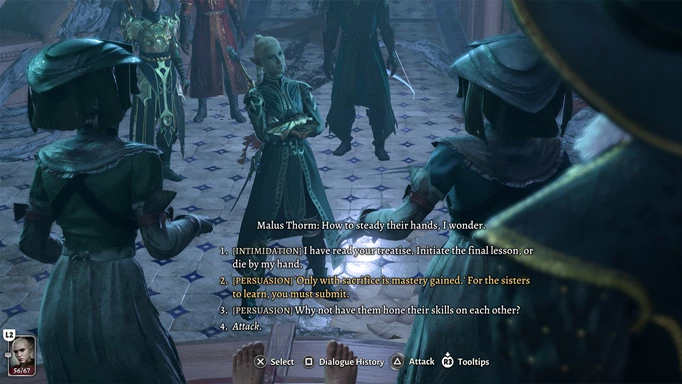
 Click to enlarge
Click to enlargeTake a break
As you explore the land of Faerûn and battle foes in turn-based combat, you’ll need to frequently rest using the camping system. There are two types available here: a Short Rest, which can be done twice a day to restore 50% of your hit points, and a Long Rest which sends you off to an actual campsite where you can sleep to restore your Short Rests, take stock of the day and interact with your camp mates.
It’s here that any companions you meet who aren’t part of your party will go - meaning that you can speak to and switch them as you like. To do a Long Rest, though, you’ll need to find Camp Supplies like apples, wine and more (a total of 40 are needed for a Long Rest), making it feel like you actually need to plan and consider when you’re going to take them and ensure you’re stocked up throughout your travels.
- Check out our review of the latest Alien title, Dark Descent
Time for battle
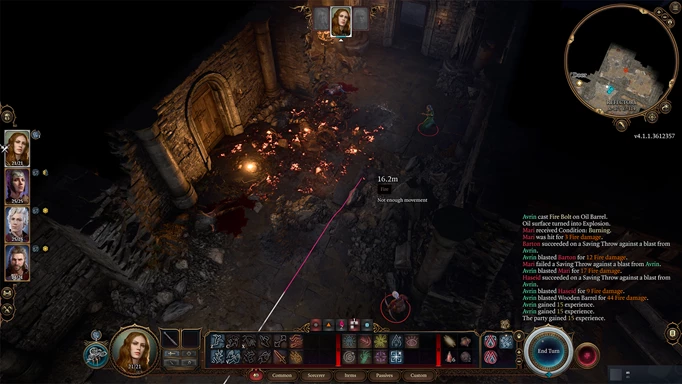
 Click to enlarge
Click to enlargeTurn-based combat might not be my usual choice for RPGs, but Baldur’s Gate 3 builds off of the excellent environmental combat of Divinity: Original Sin and its sequel.
Flinging a fire-based spell at a barrel, causing it to explode and delivering a huge amount of damage to foes on the battlefield never gets old, and it’s these elements that help you to be able to consider your environment as an additional tool when planning your attack.
As is the case with many an RPG, classes and subclasses are paramount in how you’ll approach combat overall: if you’re a Fighter, you may want to rush in and attack, whereas as a Sorcerer you’ll likely want to attempt to pepper your foes with spells from a distance. On top of that, each class also has their own features that make it unique.

 Click to enlarge
Click to enlargeFor example, with one of my chosen subclasses, a Storm Sorcerer, in battle, I’m able to fly as a bonus action until the end of a turn without the risk of being hit with an Opportunity Attack (an automatic action that can happen when an enemy moves while nearby another).
My second character, a Drow Warlock, has the 'Fey Presence' action that's unique to The Archfey subclass, which can be used to either charm or frighten those within range - perfect when you're trying to control those around you during a large-scale battle. All of these additional elements are a tactile way to further shape who you’re playing as, even in combat.
One of the most vital elements of combat in Baldur's Gate 3 is the Initiative Order, a great tool for tacticians and something that is crucial to keep an eye on in combat, as it displays the turn order of characters currently in the fight. If two of your party members are shown next to each other in this lineup, you can switch freely between them, allowing you to control multiple characters in tandem before ending your turn to strategically plan your advance.
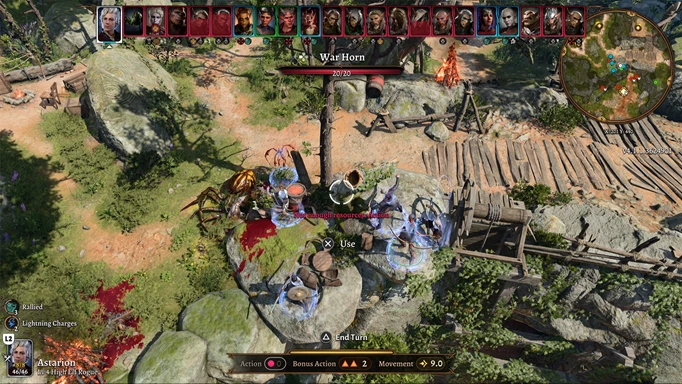
 Click to enlarge
Click to enlargeWhile playing, you’ll earn experience that goes towards levelling both yourself and your companions, and in the level-up screen, you’re able to fine-tune your class progression even further, picking additional spells or stats that fit best with how you want to approach a battle.
That's not all, though, as one of the game's central plot points - those pesky tadpoles in your brain - can also bestow you additional powers if you choose to utilise them. As you explore and defeat foes, you'll be able to find more of these tadpoles that can then be used to turn you into even more of a powerhouse, sharing them between you and your party to bestow additional boons (though some teammates may refuse this idea outright unless your dice rolls favour well).

 Click to enlarge
Click to enlargeAll in all, combat in Baldur’s Gate 3 feels slick, responsive, and certainly keeps you on your toes: On one occasion, I was in the Druid Grove when fighting a Bugbear Assassin on a large cliff: I approached it, having fought it before during early access, thinking ‘this’ll be a breeze’ - not this time, apparently.
With one fell swoop of its club, absolutely out of nowhere, my Sorcerer was flung off of the cliff down onto the ground far, far below - she needed to be resurrected after the rest of my team had been defeated. It’s a moment that completely took me by surprise and even made me do a little 'aaaaah!' out loud, even after dozens of hours within the early access period.
- Here's our review of Episode 2 of The Expanse, Telltale's most recent title
Bug's Gate
Speaking of bugbears, there’s little that’s negative to say about Baldur’s Gate 3 from my adventures throughout Faerûn, with anything unfavourable coming mostly from graphical glitches with models not animating in cutscenes, the slight delay in initiating conversations, or texture pop-in when loading into the game that lingered for quite a bit of time.
Though this wasn’t (and hasn't been) fixed by a clean install, I've noticed this happening a little less the longer I've played.
Having played my fair share of Baldur's Gate 3 with a controller too, while it's absolutely my favourite way to play due to how immersive it feels to use with the camera zoomed in to follow closely behind your character, it's not without its share of annoyances.
My main gripe here is with trying to select what you want to interact with: as you use the joystick to choose between this crate or that basket to loot, it feels frustratingly counterintuitive as it cycles between something other than what you'd expect it to - causing me an instance where I've stolen a painting instead of initiating a conversation with an NPC.
On occasion, the time it takes for a conversation to start for me is incredibly immersion-breaking, especially when seeing the now frustrating pop-up of 'Rinne started a conversation' in the bottom right, followed by nothing for what seems like a good few seconds. In times like these, it can feel like Baldur's Gate 3 is chugging along to keep up with its sheer size.
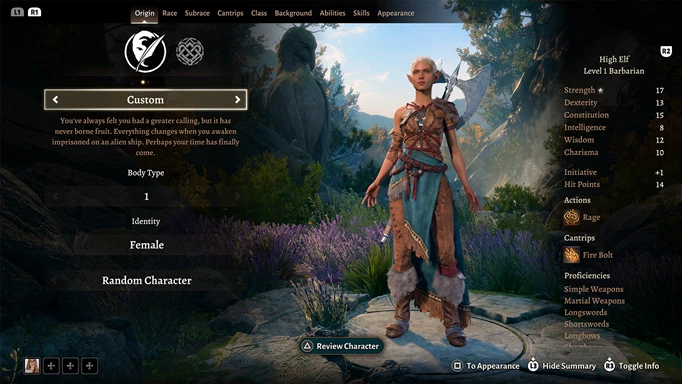
 Click to enlarge
Click to enlargeSadly, the controller-based UI pales in comparison to the mouse and keyboard version, with the character creation menu presenting the most egregious form of this, as shown above. There's also what appears to be a different font altogether that switches back and forth when going from one controller style to the other, and crowded black borders covering a large part of the screen when in the character creator.
Aside from these qualms, though, it’s clear Larian has put the utmost care into ensuring their game is as smooth as possible. What's more, it's a true testament to the quality on offer here in Baldur's Gate 3 that these niggles are the only ones that jump out at me the most.
The Verdict
Baldur's Gate 3 is a gold standard for RPGs, setting the bar incredibly high for future games in the genre - and it's something I know I'll be coming back to time and time again in the future.
With a cast of fleshed-out, fully realised characters; tactical turn-based combat that presents an opportunity to stop, think and plan your attack strategically; and a dizzying amount of customisable choices, BG3 is truly a roleplayer's dream.
Despite a few graphical glitches and some teething issues with using controllers, this isn't enough to detract from the sheer scale and how epic Baldur's Gate 3 feels. Whether you're new to the RPG genre, turn-based combat, or if it's your bread and butter, Baldur's Gate 3 is one experience you do not want to miss - and is undoubtedly a contender for our Game of the Year in 2023.
5/5
Reviewed on PC. Review code provided by the publisher.

